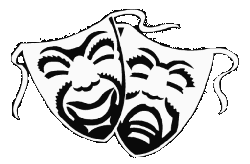

|
Photo Gallery Archive
|
(Reverse chronological order is employed so that photos
of the most recent events will be displayed first.)
Jesus Christ Superstar
Halifax West High School at
St. Patrick's Auditorium
Halifax, Nova Scotia
May, 2007
This design incorporated a more rock-show style of
lighting so as to fit the rock opera writing of this
musical. As such, the colours incorporated were much more
saturated than are typically seen with theatrical stage shows.
Full Stage
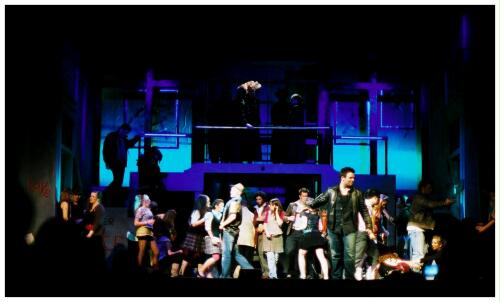 |
Judas wanders among the cast in this full-stage shot.
|
|
The set is lit in ultra-blue using 1000-watt, wide-angle
PAR 64s on the downstage pipe. Slashes of turquoise beam
in from off stage through the doorways at either side of
the upstage area. These are done using PAR 64 600-watt ray
lights positioned at the same height as the upper balconies
to give a level, sideways angle. Additional front lighting is from front-of-house 750 ellipsoidals in a straw colour. They light the extreme downstage and also supply facial light farther upstage. Backlighting in a steel colour is provided by a barn-doored, wide-angle PAR 64 located above and slightly behind the upper balcony. The light skims over the hair of the priest at Top Center and past the railing she is holding to give angled top lighting on the cast below. |
Full Stage This is the same look but without the blue and with the front-of-house lights dimmed slightly to give a more amber colour. Judas and the area to his left are lit with 1000-watt ellipsoidals in a straw colour. The side turquoise is more evident with fewer cast members, especially coming though the doorway at downstage left (your right). |
The Floor Wash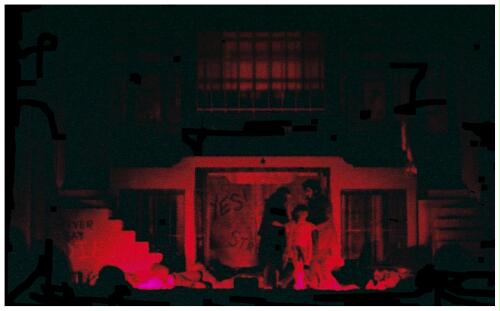 This scene is lit in magenta with two 1000-watt fresnels positioned at downstage left and right sitting right on the floor. They are barndoored to limit the light to be low on the stage and not rise above the waist. However, areas higher than that have some of the colour due to reflected light from the stage floor. |
Colours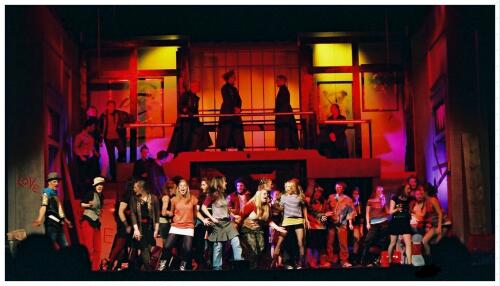 A good range of colours is displayed in this shot. The cast is lit in straw from front ellipsoidals and red from a steeper angle via wide-angle PAR 64s on the downstage pipe. Lavender streams in from the side ray lights to provide contrasting colour highlights. The pink is created where the lavender combines with the red set wash. Its actual colour may be seen in the doorway to your right where it is shaded from the red wash. The upper set is lit in yellow using 500-watt fresnels from a steep angle above and to the sides, while a third fresnel casts a dirty orange on the back wall as barely seen past the heads of the downstage cast through the center opening. |
More Colours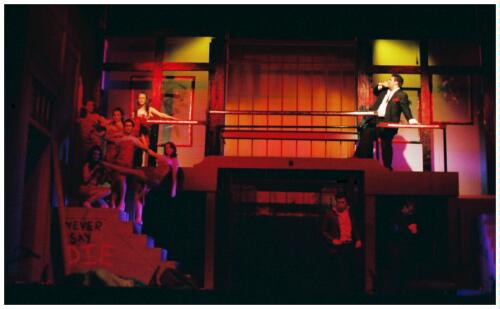 Only red washes the set from the downstage pipe. The set and the screen are lit by it and the set's walls from above in yellow. A single ellipsoidal highlights Judas. To complete the look, lavender cross-lights the set from through the upper and lower doors. It makes a pink colour where it and the red wash combine, but shows only as lavender anywhere that cannot see the red wash. This is most evident on the step risers at stage right (your left). |
|
Priests Survey the Masses Below
|
Priests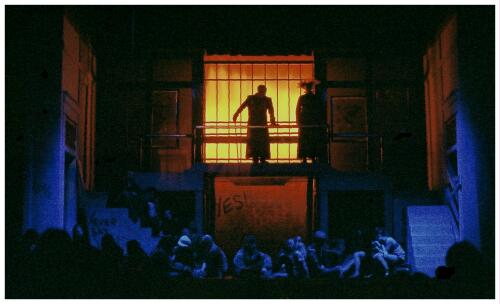
|
|
The mimimalist lighting in this scene shows the effect of
"less is more". The only lighting here is the ultra blue
for the downstage area and an orange on the rear screen,
which appears yellow due to overexposure. The screen is
lit via two 500-watt fresnels, one off to each side of
it. Some reflected screen light appears dull orange on the rear wall seen through the center opening and on parts of the set farther downstage. |
Jesus Christ Superstar
 |
Jesus lies weary and beaten at the extreme
lower left while the cast sings the title
number.
|
|
The camera was turned to a vertical position to capture
some of the white-lighting fixtures above. The central
PAR 64 is a 1000-watt narrow spot shining straight
down to create an oval pool at upper center stage. Two
additional PAR lights not seen here shine light on
this same spot from acute side angles high up downstage.
Those fixtures sported 500-watt very narrow spots.
This effect is better seen in the next photo. To either side of the center light are rows of PAR 46 marine-style spots. These project ten pools of intense white light down on to the cast while unshielded filaments radiate white light toward the audience. This extra brightening of a scene has the effect of adding power to the events on stage. |
Center White Pool This illustrates the effect of the three white lights on the upstage central area. The scene is lit in ultra blue while subdued yellow highlights the upper walls, and orange bathes the rear screen to add depth to the set. |
The Death of Jesus
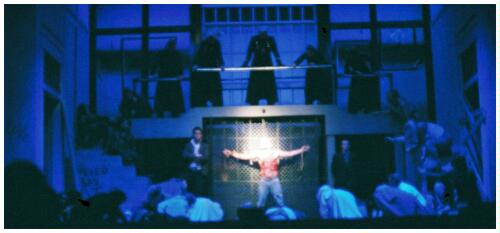 |
Jesus has been tortured and is now tied
to a fence where he dies.
|
| The full power of the ultra blue is seen here. It is so deep, it actually appears to thicken the air. The only other lighting is on the head and shoulders of Jesus. It is done in open white with two 35-watt mirror ball pinspots. |
West Side Story
Spartan Players
Keating Hall Theatre
Dartmouth High School
Dartmouth, Nova Scotia
May, 2007
For this production, Dartmouth High's stage was left wide
open to give room for the large cast and the dance numbers.
It also allowed all but one set to be on stage simultaneously.
This meant that the lighting was more critical because it was
needed to change the look to suit each set and also to focus the
audience's attention while the other sets remained visible.
Because many of the lighting fixtures used are able to be seen
in these photos, their usage may be more clearly understood by
you, the viewer of these images.
The Dance
 |
Mr. Gladhand explains the rules.
|
|
The stage is lit in steel blue using 1000-watt,
wide-angle PAR 64s from the second front-of-house
pipe. Above the stage on each side, three 500-watt
fresnels from acute angles give form to the actors.
Four are in a light yellow and two in open white to
add variety and to give slightly altered colour shadows.
Two are angled to shine on the overhanging screens to
give a sort of ceiling to the set.
These six fresnels also give lots of facial light for the actors whenever they are turned toward one another. The look is completed with a single wide-angle PAR 64 for backlighting in blue. Note that the other sets (Doc's on stage right and the dress shop on stage left) remain visible but the audience's focus is directed toward the dance area set by the lighting. |
|
Maria's and Tony's Love Grows
|
The Dress Shop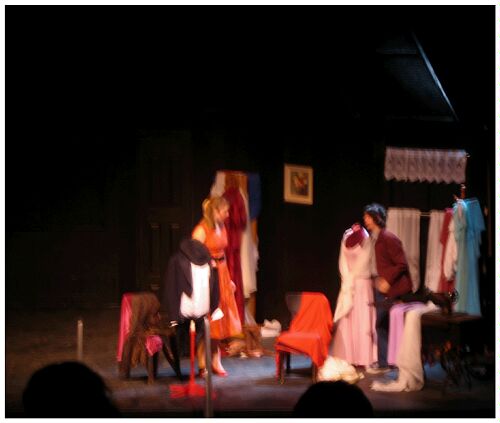 This set is lit by two 500-watt fresnels in straw while a 500-watt PAR 64 in blue, positioned behind and to the above right, adds skylight as though from the window area bin back. It shines through the screen hanging above to give an upper dimension to the look. It appears dim in this photo but was stronger to the eye. |
Night Here, the same idea as seen in the "Gladhand" photo is used to foucs the attention on the gangs outside at night as they talk about the day's events. As with the side sets, there is a set behind that is not part of this scene so it is kept in darkness; however a `Moon' pattern is projected well above it to cue the audience that this is an outdoor night scene. Each of the three groups is lit individually by 500-watt frensels in straw. As each group speaks, the others hold their stances and the lights are dimmed, appearing reddish-amber in this photo. At this point, the stage right group is the focus; the others frozen in pose. A single blue backlight illumiunates the stage floor behind the actors. |
| Tony has climbed the scaffolding to the Bedroom Window to meet Maria. |
Maria's Bedroom Window This scene is kept simple. A single 500-watt fresnel in dark steel blue illuminates the bedroom window area from the front-of house outer pipe. It comes from almost the same angle as the photograph was taken. An unseen fresnel on a floor base shines dim amber light toward the window from below Maria's right side to represent a bedroom light. One PAR 56 medium flood in moonlight blue is shone from a direct side angle on to the scaffolding. This PAR is located on the front-of-house pipe closest to the stage which is out of frame to the right and above. Part of the blue appears slightly green here due to the colour of paint on a side wall girder. |
The Rumble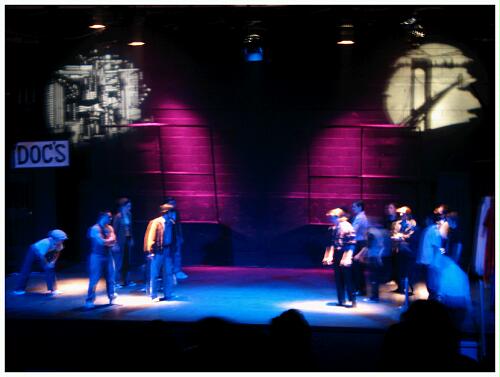 The rumble takes place under a bridge, represented here by the pattern projection at your upper right. Another pattern, along with the pink slashes, represent the city and its bright lights off in the distance. Each pattern comes from the front-of-house pipe nearest the stage via a 1000-watt ellipsoidal with a 19-degree lens system. The pinks are done with 500-watt PAR 56s using medium flood lamps turned to a vertical beam orientation. One of these fixtures may be seen hanging on the back pipe above the `Bridge' projection. The main stage area is lit from front and rear in deep blue from 1000-watt, wide flood PAR 64s. To add form, four 500-watt PAR 64s with narrow-spot lamps are hung directly over head so as to shine straight down. They are coloured in light amber to represent 1950's street lights. Three of these fixtures are visible, each above its respective pool of light on the stage floor. |
Gang members prepare to fight. |
Urinetown
St. Patrick's High School
Halifax, Nova Scotia
April, 2007
Full Stage
 |
This shows the extent to which the full
stage was used, including the bridges over
the orchestra pit.
|
|
The set and main stage here is washed using 1000-watt,
wide-angle PAR 64s with a gold tint (which unfortunately
appears very orange in the is photo). Additional front
lighting is from front-of-house 750 ellipsoidals in a
straw colour. It is used to light the extreme downstage,
but also to supply facial light farther upstage. As well,
the two bridge key lights come from this position, The upper area is lit in a gold by barndoored, 1000-watt fresnels from side positions at the top of the downstage part of the set. The upper walls on either side are lit from a high angle using 500-watt fresnels with barndoors to control spill. The colour is a deep amber, which I have dubbed "Urine Yellow". (-: A bright yellow on a white screen comes from a low-position, wide-angle, PAR 64. Diffusion gel softens the look on the screen which is placed well back on the set. This placement plus the lighting add artificial depth to the stage. |
Full Stage A dirty peach colours the set from 1000-watt, wide-angle PAR 64s. The rear screen has a diffused, deep blue. Actors at the tables are brought out by front-of-house ellipsoidals in straw, and by specifically lighting their positions. In addition, steel-blue top lighting on them comes from lights located on the downstage pipe. One pool each is at stage center and stage left (your right). Each of these areas is lit from two sides using 1000-watt ellipsoidals - one each of 26-degree and 37-degree field angles. One of two followspots located in the auditorium balcony lights the bridge at the left in yellow, while the police officer near the right bridge lurks at the boundary of the front-of-house lighted areas. |
|
Office of the Urine Good Company  The set is lit in a gold tint, which appears dark here, while the rear screen has diffused blue and yellow. The desk area is lit in straw from the front and spiked to a higher level by a yellow followspot. At stage left, the secretarial pool is lit from the front in straw and in steel-blue from the downstage pipe. |
Public Amenity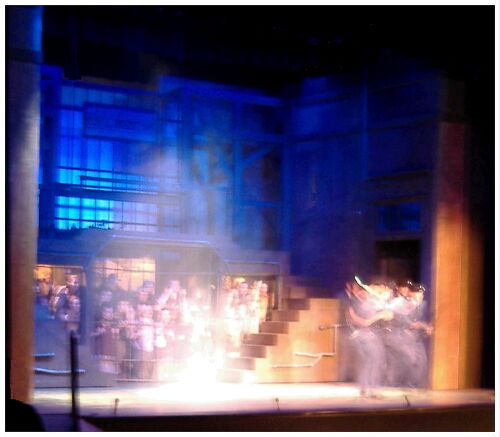 Here, a soft blue wash using wide-angle, 1000-watt PAR 64s from the downstage pipe covers the set. The actors at stage left are lit in straw from the front of house, while three pools of steel blue are created behind them by six 1000-watt ellipsoidals on the downstage pipe. Underneath are the urinal entrances. Interior lighting utilised photographer's clamp fixtures with 40-watt clear oven lamps. These were chosen because high intensity was not needed due to their close proximity to the actors. Plus, because the bulbs are not frosted, these lamps give a harsher light. The fixtures had their aluminium reflectors painted flat black to control spill. A total of six were used: two to illuminate the front areas close to the bars, two for the passageways leading to them, and two for the rear wall just visible above and behind the center actors. A light mist comes from upstage center generated by a fog machine and distributed through a fan-forced, double ducting system so mist would emerge evenly from both sides. It is illuminated by the steel blue but overexposed by the camera making it look white. |
Run, Freedom, Run The secret hideout set is lit in a dirty peach colour. Faces are brought out by a low-intensity straw from the front of house. It appears very amber at this dimmer setting. Top lighting on the midstage actors comes from the downstage ellipsoidals sporting steel blue gels. The upper area is lit in a gold with a bright yellow on the screen. A blue wash is brought up on the choir so as to have their robes stand out from the brown set and surrounding lighting. It does not show up on the set because of the other lighting, but has the effect of intensifying the blue fabric. |
|
Miss Pennywise and Secretaries 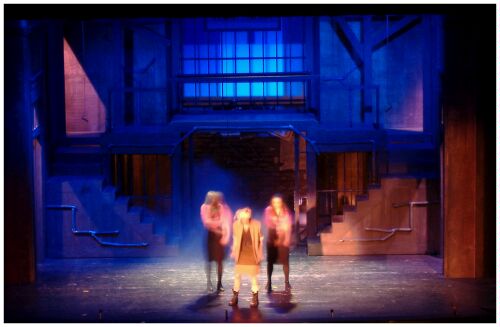 A blue wash covers the set. Upper doorways are lit from without using 500-watt fresnels with a warm lavender colour. Barndoors and the set itself control the light as it enters the top level. Downstage, the actors are lit in a flesh colour from one of the balcony followspots, while a slight amber highlights the stage at the right. A light mist emanates from the urinal entrance. Again, the center-stage pools are from ellipsoidals with steel blue gel. |
|
Officers Lockstock and Barrel Emerge from the Sewer 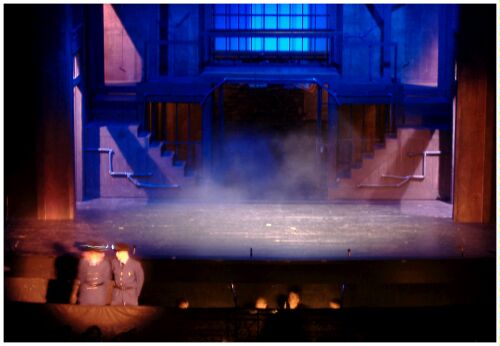 This look is the same as above except that both the upper and lower doorway lights are on. The lower ones are lit by 1000-watt fresnels in a cold lavender to contrast with the 500-watt, warm lavender for the above ones. Note the shadows cast on to the staircases by having light come through both the doorways and the windows located over top of them. The police officers are lit solely from a balcony followspot. They are standing on a platform in the orchestra pit. To the right, several musicians' faces emerge from the black. They are illuminated by light reflected from their music sheets as provided by their musicstand lights. Not visible to the audience, they are seen here because this photo was taken from the projection booth high above the main auditorium floor. |
Strong Memorial Toilet This close-up of the upper area is lit in gold from the front, while the set is in dirty peach. Yellow illuminates the rear screen. That screen is only a couple of metres behind the platform, but appears farther away due to set perspective and the lighting. In addition, the topmost platform has two side lights in dark steel blue to contrast the warmer gold and yellow. The latter is done with 26-degree ellipsoidals attached directly to the top of the set out of frame at the extreme left and right. The effect is best seen on the actor above the word "Strong". The steel colour, which contrasts well with the warmer surrounding colours, and their side positions add form to persons on the top platform. |
|
Thanks to photographers Colin Conrad, Sandy Chase, Rick Walker,
and Richard Bonner of the Halifax-Dartmouth, Nova Scotia area for
usage of their photos. |
|
Return to the |
Return to the |
|
Go to the |
|